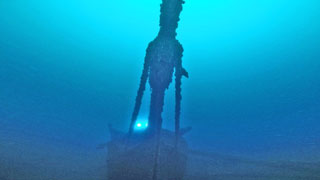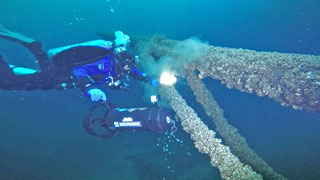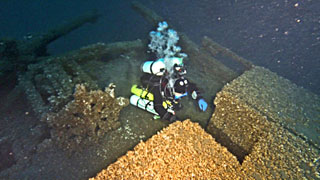
David Trotter has been involved in Great Lakes shipwreck searching, diving, exploration, and documenting new discoveries for 35+ Years.
In solving “History’s Mysteries” he has made significant contributions to the history of our Great Lakes and provided new exploration opportunities for sport and technical divers to enjoy.
His Discoveries have been featured on the Discovery Channel, PBS, NBC, and in The New York Times, Detroit News, Detroit Free Press, “Wreck Diver”, “Immersed”, “Canadian Diver” and “Lakeland Boating”.
David’s articles on Great Lakes shipwrecks have been published in historical journals and national scuba diving publications.
He has searched and discovered shipwrecks in all the Great Lakes (except Lake Ontario). In a unique odyssey, the 15 years of dedicated effort to discover the largest schooner built in Canada (the 250’ Minnedosa) has now resulted in surveying over 2,000 square miles of Lake Huron. This has been a one of a kind adventure with 90 new sites found; including Airplanes, the steamer Daniel J Morrell, the steamer W. C. Franz, the Schooner Marion Egan, the Hydrus and the steamer Goliath (naming just a few of the discoveries). The Goliath was designed by John Ericsson in 1846, fifteen years before he designed the ironclad “Monitor” of American Civil War fame.
David believes the Great Lakes are “Our Treasure” to be enjoyed by all who love our “Inland Seas” and our maritime history. It is the shipwreck hunter discovering and the diver exploring a shipwreck (in 20’ or 300’ of Water) that has that unique experience of traveling back into time.
Our World-Underwater (Chicago) honored David’s contribution to diving and Great Lakes maritime history by presenting him with the special 2010 OWU Achievement Award. In 2016, the Association for Great Lakes Maritime History (AGLMH) honored David with the prestigious C. Patrick Labadie Award For Historic Preservation. Dave’s web site is www.shipwreck1.com
Fire, Smoke and Wind: The Discovery and Exploration of the Schooners Montezuma and Venus
Etched deeply into the history of the “Thumb” of Michigan are the Great Fires of 1871 and 1881. The fire of 1871 destroyed forests, farms, homes and families, and developed a great haze that covered large sections of Lake Huron.
The Schooner Montezuma departed from Chicago with 16,300 bushels of corn destined for Buffalo, New York. It was a voyage she would not complete, as the Schooner Hattie Johnson, sailing mid-lake, moved into the thick Lake Huron haze and plunged deeply into the portside of the Monetzuma on October 3, 1871. The loss of the 140’ Montezuma in deep water has preserved one of the oldest built vessels on the floor of Lake Huron. Intact, she is a shipwreck explorer’s dream and a delight for historians to enjoy. Share the excitement as we explore a ship that went missing for 145 years!
Grindstone City, Michigan, in the 1800’s, was the grindstone capital of the world, producing high quality grindstones used thoughout the country and overseas. Two long piers jutted out into Lake Huron to accommodate the loading of grindstones on scows, and then off loaded onto larger vessels in deeper water. These grindstones were then distributed worldwide. The Schooner Venus departed Grindstone City on October 2, 1887 with a full load of grindstones stacked on her deck and in her cargo holds, destined for Milwaukee, Wisconsin.
With a captain and crew of five, the Venus sailed on to Lake Huron, into the Gales of October, and then into oblivion. Missing for more than 125 years, her intact image appeared on the sidescan sonar in deep water. Investigating and documenting this deep water shipwreck (300’) required extensive planning. Especially shooting the important video that tells the story of this amazingly intact shipwreck. The Venus is the only ship lost in Lake Huron while carrying a full load of grindstones. It is a Great Lakes adventure for all to enjoy!






